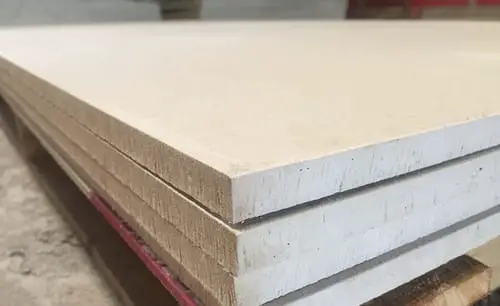By definition, decoupling membranes refer to plastic or polyethylene mats that create an air space between the substrate and floor tiles. Hence, allowing independent movement between the 2 surfaces and limiting the transmission of stresses. Simply put, they allow the substrate and the floor tiles to ‘un-couple’ when there is force benign applied from underneath.
On the other hand, a cement board is a thin concrete layer whose sides feature a fiberglass mesh. It also provides a firm and uniform surface for tiles to bond to. More importantly, they are used to prepare the subfloor to prevent the tile from lifting or cracking over time.
Difference Between Uncoupling Membrane and Cement Board
However, despite being used to perform the same task, there are some notable differences between these materials. And in this section, I’ll take you through them one by one –
1. Longevity
In general, uncoupling membranes are flexible and can withstand high pressure. So they’re more durable compared to cement boards. Besides, most decoupling membranes are made from efficient and sustainable polymers. Not to forget that they’ve low inflammability and outstanding resistance against chemicals and stains.

As a result, uncoupling mats are strong and resilient, preventing them from wear & tear. This, however, doesn’t mean that cement boards are not durable or resilient.
Instead, they have an incredible ability to withstand weather elements and harsh chemicals like strong alkalis and acids. Nonetheless, cement boards can be vulnerable to significant pressures and loads.
2. Thickness
Uncoupling membranes are only ⅛” thick. For that reason, they’ll increase the floor height by an insignificant amount. Nonetheless, the installation of these mats results in a mortar layer on both sides of the mat. Interestingly, this structure increases its efficiency by distributing the exerted pressure uniformly.
Compared to cement boards, however, decoupling membranes are usually thicker. One reason for this is that cement boards are crafted from fine cement with glass/ fibrous mesh. As a result, their thickness often resembles that of a plywood or gypsum board.
3. Flexibility
Since cement boards are strengthened with fibers, they’re hard and less flexible than uncoupling membranes. And although there are certain types of cement boards you can use on contoured and curved surfaces, they’re not that flexible.
Instead, they crack and break easily when subjected to pressure. Decoupling mats, on the other hand, are quite flexible, thanks to the polyethylene material. For that reason, they can easily withstand vibrations as well as high pressure.
4. Installation
Cement boards are often glued over the subfloor surface, giving them more strength than decoupling mats. You’ll only need a single layer of cement boards with high-quality fibers and cement. Yet it will stick perfectly to the concrete surface.
In addition, you can fasten the cement boards with screws to ensure that they adhere well to the countertop/ floor. Unfortunately, this means that they’ll not be as effective as uncoupling mats in crack protection. Even worse, cement boards aren’t completely waterproof, so some moisture may still pass through the subfloor.
On the contrary, the installation of uncoupling mates requires more time and effort. It’ll also require 2 mortar layers to support the load of the floor being consisted of 3 different layers.
That is; the 1st mortar layer, polythene layer, and the 2nd mortar layer. Fortunately, despite having 3 layers, the uncoupling mat adheres well to concrete surfaces. Better still, you don’t need any fasteners to hold them to your subfloor. More importantly, they’re easier and faster to install since you can easily cut them with a utility knife without producing dust.
Is Uncoupling Membrane Better than Cement Board?
Uncoupling membranes are completely waterproof, unlike cement boards which are susceptible to water damage. So, if moisture from underneath is of major concern, uncoupling membrane is a better option which also doesn’t increase the floor height as much compared to cement boards.
Also, underlayment mats allow lateral movement of substrates, thus proving crack isolation protection. On the contrary, cement boards don’t offer crack protection to tiles since they’re screwed down to the subfloor.
On the downside, uncoupling mats require the subfloor to be very strong. For that to happen in a wooden subfloor, you need at least 2 layers of plywood as well as close joist spacing.
Conclusion
You can use underlayment over the subfloor and concrete slabs with defects like high moisture levels or depressions. Similarly, underlayment act as a stable substrate when installing tiles on oil asphalt or other smooth surfaces where adhesion is an issue. Contractors often use them when installing tiles on countertops and shower floors.
However, this doesn’t mean that you can only use decoupling membranes on concrete slabs. Instead, you can also use them on wooden subfloors as long as they don’t need extra stiffening with cement boards.
